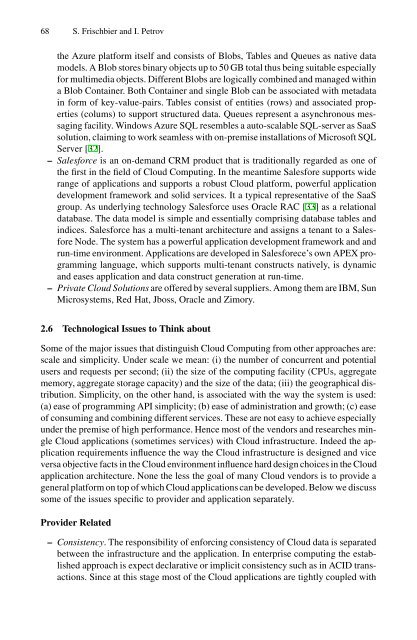Aspects of Data-Intensive Cloud Computing - DVS - Technische ...
Aspects of Data-Intensive Cloud Computing - DVS - Technische ...
Aspects of Data-Intensive Cloud Computing - DVS - Technische ...
You also want an ePaper? Increase the reach of your titles
YUMPU automatically turns print PDFs into web optimized ePapers that Google loves.
68 S. Frischbier and I. Petrov<br />
the Azure platform itself and consists <strong>of</strong> Blobs, Tables and Queues as native data<br />
models. A Blob stores binary objects up to 50 GB total thus being suitable especially<br />
for multimedia objects. Different Blobs are logically combined and managed within<br />
a Blob Container. Both Container and single Blob can be associated with metadata<br />
in form <strong>of</strong> key-value-pairs. Tables consist <strong>of</strong> entities (rows) and associated properties<br />
(colums) to support structured data. Queues represent a asynchronous messaging<br />
facility. Windows Azure SQL resembles a auto-scalable SQL-server as SaaS<br />
solution, claiming to work seamless with on-premise installations <strong>of</strong> Micros<strong>of</strong>t SQL<br />
Server [32].<br />
– Salesforce is an on-demand CRM product that is traditionally regarded as one <strong>of</strong><br />
the first in the field <strong>of</strong> <strong>Cloud</strong> <strong>Computing</strong>. In the meantime Salesfore supports wide<br />
range <strong>of</strong> applications and supports a robust <strong>Cloud</strong> platform, powerful application<br />
development framework and solid services. It a typical representative <strong>of</strong> the SaaS<br />
group. As underlying technology Salesforce uses Oracle RAC [33] as a relational<br />
database. The data model is simple and essentially comprising database tables and<br />
indices. Salesforce has a multi-tenant architecture and assigns a tenant to a Salesfore<br />
Node. The system has a powerful application development framework and and<br />
run-time environment. Applications are developed in Salesforece’s own APEX programming<br />
language, which supports multi-tenant constructs natively, is dynamic<br />
and eases application and data construct generation at run-time.<br />
– Private <strong>Cloud</strong> Solutions are <strong>of</strong>fered by several suppliers. Among them are IBM, Sun<br />
Microsystems, Red Hat, Jboss, Oracle and Zimory.<br />
2.6 Technological Issues to Think about<br />
Some <strong>of</strong> the major issues that distinguish <strong>Cloud</strong> <strong>Computing</strong> from other approaches are:<br />
scale and simplicity. Under scale we mean: (i) the number <strong>of</strong> concurrent and potential<br />
users and requests per second; (ii) the size <strong>of</strong> the computing facility (CPUs, aggregate<br />
memory, aggregate storage capacity) and the size <strong>of</strong> the data; (iii) the geographical distribution.<br />
Simplicity, on the other hand, is associated with the way the system is used:<br />
(a) ease <strong>of</strong> programming API simplicity; (b) ease <strong>of</strong> administration and growth; (c) ease<br />
<strong>of</strong> consuming and combining different services. These are not easy to achieve especially<br />
under the premise <strong>of</strong> high performance. Hence most <strong>of</strong> the vendors and researches mingle<br />
<strong>Cloud</strong> applications (sometimes services) with <strong>Cloud</strong> infrastructure. Indeed the application<br />
requirements influence the way the <strong>Cloud</strong> infrastructure is designed and vice<br />
versa objective facts in the <strong>Cloud</strong> environment influence hard design choices in the <strong>Cloud</strong><br />
application architecture. None the less the goal <strong>of</strong> many <strong>Cloud</strong> vendors is to provide a<br />
general platform on top <strong>of</strong> which <strong>Cloud</strong> applications can be developed.Below we discuss<br />
some <strong>of</strong> the issues specific to provider and application separately.<br />
Provider Related<br />
– Consistency. The responsibility <strong>of</strong> enforcing consistency <strong>of</strong> <strong>Cloud</strong> data is separated<br />
between the infrastructure and the application. In enterprise computing the established<br />
approach is expect declarative or implicit consistency such as in ACID transactions.<br />
Since at this stage most <strong>of</strong> the <strong>Cloud</strong> applications are tightly coupled with















